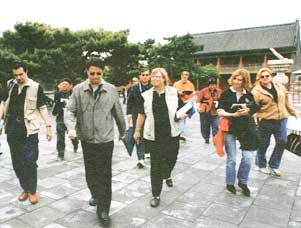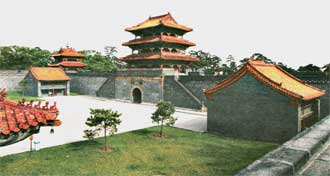|
|
 |
 |
 |
 |
 |
 |
| |
Man Mountain (page2)
Source :
Date : 11 Jun 2004
|
extracted from TheEdge (THE WEEK OF JUNE 28 - JULY 4, 2004)
In its earliest form, feng shui was indeed used to orient the homes of the dead rather than the living. The term
itself appears first in a passage from the Book of Burial, which dates to no earlier that the 4th century CE. For
this reason, many of the sites we will visit are imperial tombs of the Qing emperors and their ancestors, who believed
that where your ancestors are buried has great bearing on the fortune of your descendants. Hence, a city in Shenyang,
today a grey and very unlikely tourist hotspot, becomes a focus point.
Shenyang was a Mongol trading centre in the 11th century and became the Manchurian empire’s capital in the 17th century.
Upon the Manchurian conquest of Beijing in 1644, it became a secondary capital under the Manchu name of Mukden and a
centre of ginseng trade. The Russians, who occupied the city at the turn of the century, introduced industrialisation.
Their efforts were continued by the Japanese, the victors of the Russo-Japanese war from 1904 to 1905. Thus, historically,
Shenyang has had many masters – the warlords, the Japanese, the Russians, the Kuomintang and the Chinese Communist Party.
 |
Yap (right, in grey jacket) devised the Master Excursion Series to give feng shui students the
practical experience of 'walking the mountains', allowing them to test classroom theories via the experience of real,
historic examples. |
However, very few traces of its rich history are apparent as we travel through the city streets to the outskirts to
view these ancient death monuments. The contrast between the old Shenyang and new Shenyang is stark. Where the ancient
tombs exude serenity and other worldliness, the city centre is characteristically rapid but vapid; almost “seismic” in
activity, observes a member of Yap’s team. Shenyang’s present surroundings no longer reflect the thoughtfulness that
clearly went into the original construction of its historical buildings, a few which are now gazetted as Unesco World
Heritage sites.
Modern Shenyang is a largely industrial landscape of huge stacks, dark smog and faceless monoliths. Like much of China,
it has also evolved into one big shopping mall, its seemingly endless underground network of shops filled with
“good quality counterfeit products” – shoes, clothes, cosmetics. It has most of the ingredients for an interesting stay:
a fashionable shopping district; a world-famous dumpling restaurant (“300 years old,” quips our tour guide); China’s
other Forbidden City; tombs of two former emperors; and architecture left over from Japan’s occupation. And that’s what
Shenyang feels like – a collection of curios out of sync with its present, industrial surroundings.
One spot at the town centre stands out amidst the new swanky hotels and government offices that flank the main road.
The larger than life Mao Zedong statue, built during the frenzied height of the Cultural Revolution, stands in the
middle of Zhonghua Square, a very big roundabout smack in the middle of typically random China traffic. Mao stands
proud, surrounded by a teeming mass of soldiers, peasants and workers, all bearing weapons of the revolution, staring
grimly at the numerous banks and even more numerous hotels that now surround him. Still, communal activities revolve
around Mao in the evenings, when the public congregate, despite the pollution, to fly kites, do tai chi, practise
ballroom dancing in droves, and catch up after a long day. It’s something you don’t see enough of in many other Asian
cities.
 |
Zhaoling, one of the Three Early Qing Tombs, provides a good example of the application of Flat Land Dragon Theory. |
The tombs of Shenyang, situated in the Liaoning Province, also known as The Three Early Qing Tombs, house the
remains of the three earliest rulers of the Manchus. There is Yongling (originally known as Xingjingling), Fuling,
located in the eastern suburbs of Shenyang (also known as the Eastern Tomb), and Zhaoling, to the north of Shenyang
(the Northern Tomb).
As we move away from the city towards out first destination, the Yongling tombs, Yap highlights to the group how
the quality of the Dragons (mountains) is starting to change. Exotic names of Mountain Luan Tou (forms) are thrown up
– Imperial Seal, Huge Door, Greedy Wolf, Camel Mountain and Sky Horse. The clicking sound of cameras intensifies from
within the bus all through the long approach towards Yongling from the main gateway.
Even feng shui disbelievers cannot help but be awed by the inspiring model of feng shui mountain-forms that harbour
sweet spots of Qi, which grow more abundant the closer you get to them. They appear as someone resting peacefully,
embracing treasure – “embraces” that may be continually “sent out” and reciprocated throughout the mountain range in
scenes reminiscent of classical Chinese paintings.
The plans and design of the actual tombs show clear features of northeast China and the early Manchu customs. We are
first taken through each tomb tourist-style, with commentaries of historical facts laced with legend. Yongling is the
tomb of Nuerba, the grandfather of Nuerhachi. According to Chinese history, it was Nuerhachi who unified the NüZhen
tribes (later known as Manchus). His son, Huangtaiji, is the founder of the Qing Dynasty.
One story tells of how Nuerhachi, attempting to find a good spot to place the ashes of his ancestors, placed the urn
to rest between the branches of a tree before moving on to search for a feng shui master. They discovered through
the master’s calculations that the location was a choice one, with the surroundings drawn to that one spot, the
Dragon Spot. One of the tomb’s most critical features are the 12 small lumps that travel like a dragon’s vein
across a small mountain range that envelope the tombs, said to have enabled the 12 generations of Qing emperors
that followed.
After each historical overview provided by local guides, the students of the excursions are let loose with their
own Luo Pan (compasses) to explore the site on their own. After verifying the conventional feng shui wisdom for
themselves, they must find out if they can replicate it, if they want to replicate it, and whether it can be applied
to them or their clients. Then, still as the site, a discussion ensues with Yap as moderator.
Yap puts the excursions into context: What people know as classical feng shui today are the formula-based
versions, most popularly the 8 Mansions and Flying Stars. The former is used for personal direction and the
latter for house analysis. Yap says that this is all “internal feng shui”; no actual formations such as landforms,
mountains forms or water forms are studied and taken into account in the reading.
Yin house feng shui focuses on the placement of tombs; the Qing Dynasty’s ancestors were not able to change their
own lives or that of their sons, but they could change the lives of their future-born. “You must be in tuned to the
right channel. So, you’re the antenna; your descendants are the television. If you tune it correctly, you will get
the effects.” Yap is clearly in his element. “It’s fascinating to study landforms and formulas to calculate, assess
how these environmental features in time affect not just one person, but a whole generation. Twelve generations.”
Page 2 of 3 < Previous Page | Next Page >
|
|
|
|
 |
|
 |
|